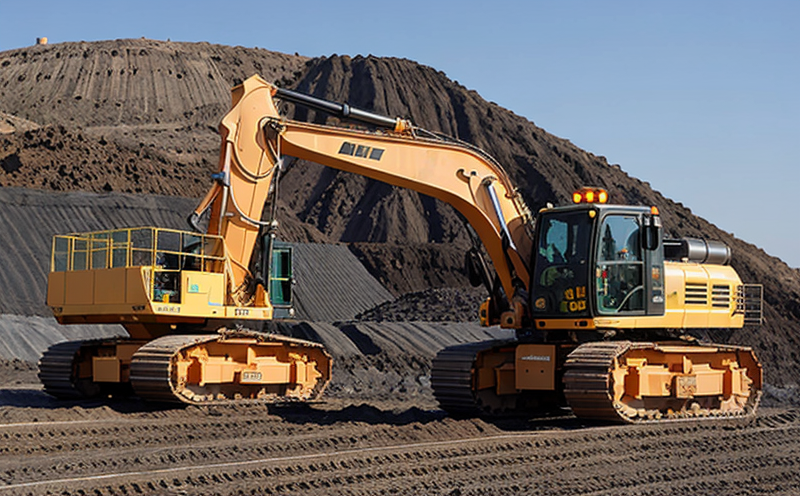SAE J1078 Performance Testing of Earthmoving Machinery Steering
The SAE J1078 performance test is a critical process ensuring that earthmoving machinery, particularly the steering systems of these machines, meet stringent safety and operational standards. This testing method evaluates the structural integrity, durability, and overall performance of the steering mechanisms under simulated real-world conditions.
Earthmoving equipment plays a pivotal role in the mining industry, where heavy-duty vehicles are required to navigate rugged terrain efficiently and safely. The SAE J1078 test helps ensure that these machines can perform optimally even in adverse environmental conditions such as dust, humidity, and extreme temperatures. Compliance with this standard is essential for operators looking to enhance safety and productivity while minimizing equipment downtime.
The testing procedure involves subjecting the steering mechanism to a series of stress tests designed to simulate actual operational demands. These tests can include dynamic loadings that mimic the forces experienced during operation, as well as static assessments that examine the structural integrity under various angles of deflection and force application. The test setup often includes specialized fixtures and sensors capable of capturing detailed data on performance metrics such as deflection, torque, and angle.
For quality managers and compliance officers, adhering to SAE J1078 ensures that the equipment meets industry best practices. This is particularly important in sectors where safety regulations are stringent, such as mining operations. By conducting this test, manufacturers can demonstrate their commitment to producing reliable machinery, which enhances customer confidence and operational safety.
R&D engineers benefit from SAE J1078 testing by gaining insights into the limitations and potential improvements of current steering systems. This data allows for iterative design enhancements that could lead to more efficient and robust equipment. Similarly, procurement personnel can leverage this information to source components that are optimized for performance in harsh environments.
The SAE J1078 test is not merely a compliance exercise but an integral part of the quality assurance process. It ensures that earthmoving machinery meets or exceeds industry benchmarks, thereby contributing to safer and more productive operations in mining environments.
Applied Standards
The SAE J1078 test is widely recognized as a benchmark for evaluating the performance of steering systems in earthmoving machinery. This standard is part of the broader suite of SAE International standards that address various aspects of automotive and aerospace engineering. The specific criteria outlined in SAE J1078 provide clear guidelines on how to conduct these tests, ensuring consistency across different manufacturers.
The test protocol includes a series of steps designed to simulate real-world operational conditions. These include static load testing to assess the structural integrity at various angles and dynamic loading tests to evaluate performance under simulated driving conditions. The use of ISO 13849-1 for safety-related parts is often recommended in conjunction with SAE J1078, as it provides additional criteria for ensuring that safety features meet international standards.
For mining equipment manufacturers and operators, adhering to these standards is crucial. Not only does it ensure compliance with regulatory requirements but also enhances the reputation of the product. By meeting these stringent test protocols, companies can demonstrate their commitment to quality and reliability, which is particularly important in an industry where safety is paramount.
The application of SAE J1078 extends beyond just the steering system; it encompasses a holistic approach to ensuring that all components interact seamlessly under various operational conditions. This comprehensive testing ensures that the entire machine operates efficiently and safely, contributing to a safer working environment for operators and maintenance personnel.
Why Choose This Test
The SAE J1078 performance test offers several advantages over other testing methods. One of the primary reasons is its ability to simulate real-world operational conditions, providing a more accurate assessment of how the steering system will perform in actual use. This realism ensures that any potential issues are identified early in the development or maintenance process.
Another significant advantage is the standardization it provides. By adhering to SAE J1078, manufacturers can ensure that their products meet international standards, which enhances customer confidence and marketability. This consistency also simplifies compliance with regulatory requirements, making it easier for companies to enter new markets.
The test's durability aspect is particularly beneficial for mining equipment, where machines are exposed to harsh environments and rigorous use. SAE J1078 helps manufacturers identify potential weaknesses in the steering system before they become critical issues, allowing for timely repairs or design modifications. This proactive approach not only extends the lifespan of the equipment but also reduces downtime and operational costs.
Moreover, the test provides valuable data that can be used to improve product performance. By analyzing the results, manufacturers can identify areas for improvement in both design and manufacturing processes. This continuous improvement cycle ensures that products remain competitive and meet or exceed customer expectations.
Competitive Advantage and Market Impact
The SAE J1078 performance test offers a significant competitive advantage by providing a clear benchmark for quality and reliability. Compliance with this standard can differentiate a company's products in the market, making them more attractive to customers who prioritize safety and efficiency.
By demonstrating a commitment to meeting or exceeding industry standards, companies can build trust and loyalty among their customer base. This trust is particularly valuable in industries like mining, where safety is a top priority. Operators are more likely to choose equipment that has been rigorously tested and proven reliable, which can lead to increased market share.
The test's impact on the market extends beyond individual companies; it contributes to the overall improvement of the industry as a whole. By setting high standards for performance testing, SAE J1078 helps raise the bar for all participants in the mining equipment sector. This collective advancement leads to safer and more efficient operations across the board.
The data generated from SAE J1078 tests can also be used strategically by companies to inform marketing efforts. Highlighting compliance with this standard can position a company as a leader in safety and reliability, which is particularly important for attracting business from large mining operations that require high levels of trust.





